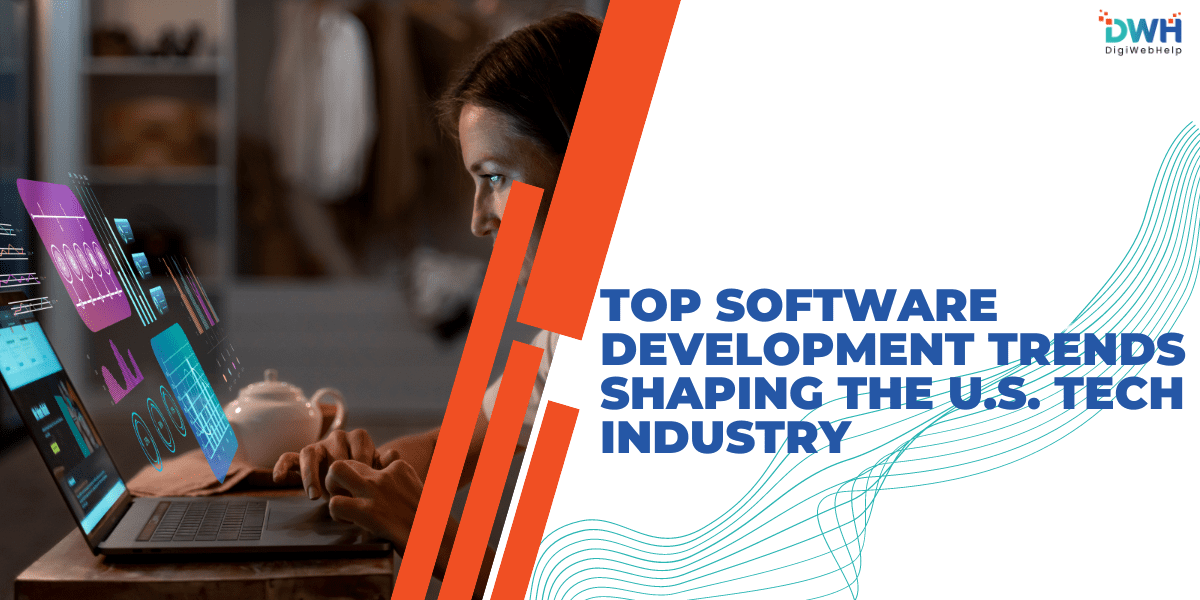
Top Software Development Trends Shaping the U.S. Tech Industry
The US tech industry is at the forefront of innovation, driving global advancements in various sectors. As new technologies emerge and existing ones evolve, software development has become a key enabler of this growth. Businesses across all industries rely on the latest trends to stay ahead of the competition, enhance their efficiency, and deliver superior user experiences to their customers. It’s crucial for businesses to stay informed about the latest software development trends to navigate the complexities of the modern tech landscape.
In this blog, we’ll explore the top software development trends influencing the U.S. tech industry and discuss their implications for the future.
1. The Rise of AI and Machine Learning
Artificial Intelligence (AI) and Machine Learning (ML) are revolutionizing the software development process, offering exceptional capabilities to automate tasks, analyze large volumes of data, and make smart decisions. The integration of AI/ML in software development has recently accelerated, helping developers craft smarter, more adaptive applications.
AI-powered automation is a key trend—it’s helping developers streamline repetitive tasks like code generation, testing, and deployment. Tools like AI-powered code assistants and automated testing frameworks reduce development times and minimize human errors. This boosts the development efficiency and allows coders to concentrate on more complex and creative aspects of the development process.
AI and ML are driving innovations across various industries. In healthcare, AI-powered software can analyze medical images with greater accuracy, sometimes better than human experts. This helps in earlier diagnoses and improved patient outcomes. In finance, machine learning algorithms are utilized to identify fraudulent transactions and optimize investment strategies.
2. Cloud-Native Development
Cloud-native development is transforming the way software is designed and deployed. Developers use the power cloud to develop scalable, flexible, and affordable applications that can be rapidly deployed. This cloud-native approach has become increasingly popular among businesses as it allows them to modernize their infrastructure and improve their agility in the market.
The use of microservices architecture is a key component of this trend. Instead of developing monolithic applications, developers are breaking them into smaller, independent services. These can be developed, deployed, and scaled separately. This approach enables faster development cycles and easier deployment as each service can be updated without affecting the entire application.
Major cloud service providers, like AWS, Google Cloud Platform, and Microsoft Azure, are setting the pace by offering many tools and services to support cloud-native development. Such platforms equip developers with the necessary infrastructure and services to build, deploy, and manage cloud-native applications.
3. DevSecOps: Security-First Development
The shift from DevOps to DevSecOps represents a fundamental change in the development process. Traditionally, security was often thought of until later in the development process. Sometimes, it was only thought of after the software was deployed.
However, with cyber threats on the rise and software systems getting complex, security must be the top priority from the start. This is where DevSecOps comes in. It emphasizes the integration of security into every stage of the software development process. This starts at the very beginning with planning and design and goes all the way through the deployment.
This approach ensures that the security vulnerabilities are identified and addressed in the earlier stages. This lowers the chance of security breaches and improves the overall application security. To support this security shift, new tools and practices have emerged. Tools like static and dynamic security testing (SAST and DAST) can be used to analyze software code for security vulnerabilities. While other container security tools ensure that containerized software is secure. Additionally, automated security testing helps developers keep security in mind during development.
4. Low-Code and No-Code Development
The demand for software is growing faster than the supply of skilled developers. This has led to the rise of low-code and no-code development platforms. These platforms allow users with basic or no coding skills to create apps using visual interfaces and ready-made components, speeding up the software development process.
Low-code and no-code platforms are making software development accessible to everyone, including business users. These “citizen developers” can custom-develop apps to suit their needs without the help of expert coders. This trend is particularly valuable for small businesses and startups who might not be able to afford a full team of developers.
However, these platforms also have limitations. Complex applications with highly personalized features may still require traditional coding approaches. There are also concerns about security, scalability, and maintenance, especially with apps made on no-code platforms.
Despite these challenges, more people are expected to use low-code and no-code platforms since they help overcome the shortage of software development skills. As these tools continue to get better, they’ll become increasingly crucial in defining the future of software development.
5. Edge Computing and IoT Integration
The rise of Internet of Things (IoT) devices and the need for real-time data processing has given rise to edge computing. It has become the latest trend that is reshaping the software development process. Unlike traditional cloud computing, where data is processed in centralized data centers, edge computing brings computation and data storage closer to the IoT devices that generate the data. This reduces latency, boosts performance, and enables real-time decision-making.
Industries such as production, healthcare, and transport find edge computing particularly valuable because they need real-time data processing. For example, in production, edge computing can monitor equipment in real time, detect anomalies, and predict maintenance needs before anything breaks down.
In healthcare, it can enable real-time monitoring of patient vital signs. This lets healthcare providers intervene quickly if needed. IoT’s integration with edge computing is enhancing the capabilities of these systems. IoT gadgets generate heaps of data. Processing this data at the edge reduces the need for constant communication with the cloud, which saves bandwidth and speeds up response times.
Conclusion
The software industry is in a constant state of flux, driven by the rapid pace of technological advancements and changing market demands. The software development trends highlighted in this blog are shaping the software development landscape, setting the stage for future innovations. Businesses need to stay informed about these trends to stay in the competition. With the right tools and practices, they can position themselves at the forefront of the U.S. tech landscape, driving innovations and delivering exceptional software development services.
Ready to stay ahead of the curve? Explore how adopting these software development trends can transform your business. If you’re looking to innovate, enhance security, or scale efficiently, it’s time to integrate these cutting-edge software development trends into your software development.










